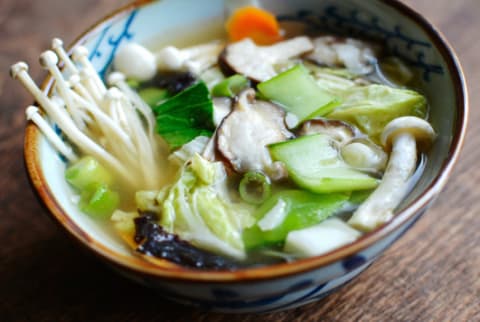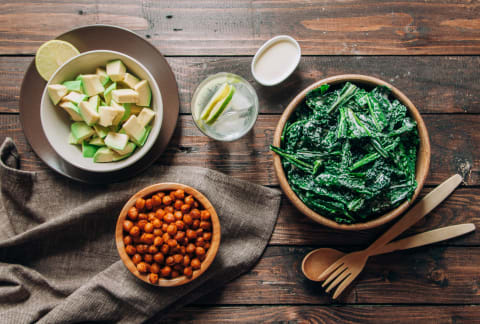Advertisement
Seaweed Is The New Kale: A Doctor Explains


When you were a kid, you were probably frequently told to "eat your greens." Fast-forward a few decades, and now all of us in the sustainable wellness community are echoing—and amplifying—that parental sentiment.
The difference between then and now is that today more people are embracing diets rich in nutrition-packed plants, enjoying more access to fresh, whole, greens. They now understand that the phytonutrients found in greens play an essential role in helping to support healthier lives, less burdened by disease and chronic illness. And while we’re all pretty familiar with the classic greens like spinach, one of the more recent additions to the healthy greens list is seaweed—an ocean-grown veggie that’s worth getting to know better.
Here’s why I recommend eating more of this health-supporting gift from the sea, and how you can enjoy more of it:
1. It’s the new superfood that's anything but new.
When you Google "seaweed," you’ll see a lot of headlines proclaiming seaweed the new kale—and they’re right. It’s heavy on nutrition, light on empty calories, and comes with an array of superfood benefits.
Though some might call it a trendy veggie, in many cultures, particularly those with plenty of coastline, seaweed has been an essential food and rich source of nutrients for thousands of years. While it’s been a staple of Japanese and Chinese cuisine, and eaten by many of our ancestors across Europe and the British Isles, until recently most Americans have had little exposure to it, save for the occasional sushi meal (but that’s starting to change).
2. Seaweed has nutrients—and lots of 'em.
What’s inside that seaweed? Well, there are many different kinds, each with similar but varying nutritional values. In general, though, most are good sources of iodine. This is important because our bodies don’t produce iodine but need it in order to make thyroid hormones. You’ll also generally find vitamin A and C and the B’s, plus calcium, magnesium, iron, fiber, amino acids, and good fats.
Add to that antioxidant, antifungal, and anti-inflammatory properties, and this plentiful veggie-from-the-sea is the total package for anyone looking to support their health. Of special interest to women: Some studies have suggested that seaweed may be helpful for regulating estrogen, which can help mitigate PMS symptoms and possibly reduce breast cancer risk.
3. Seaweed is super sustainable.
What’s also super appealing about seaweed is that it’s fairly easy to "farm," with nature doing much of the heavy lifting. It’s super-sustainable, growing quickly with some types gaining 5 to 10 inches in single a day. Seaweed reaches anywhere from 20 to 100 feet in length depending on the species, so to say it grows abundantly is an understatement.
But what’s truly amazing about seaweed is that, despite all that fast and copious growth, it consumes few, if any, natural resources. The seeds attach to rocks on the ocean floor, and the seedlings take off from there, cleaning the surrounding waters as they grow.
How to enjoy more seaweed
Before you dive in, there are few things to keep in mind. First, buy the best quality possible. As with land veggies, look for seaweed that’s minimally processed, dried without additives or preservatives, and harvested from clean waters. While most seaweed will arrive at the store dried, the good news is that the majority of the nutrients will remain intact, so you’ll still enjoy the benefits.
For most people, adding seaweed to the diet in moderation doesn’t pose a problem—but check with your doctor first, particularly if you have kidney or thyroid issues, are pregnant or are on certain prescription medications.
While there are many different types of seaweed, the most commonly used and widely available ones are kelp, nori, and dulse. The question is what to do with them. Here are some simple ways to enjoy them:
Kelp: Enjoy in noodle form and make a meal of them. Rinse off the salty water they’re usually packaged in and add a little pesto and a pile of chopped raw, fermented, or sautéed veggies. Top with fish or poultry, and dinner is served. Or try adding kelp noodles to add flavor and heartiness to soups.
Nori: Most of us are familiar with those slightly crispy, dark green sheets that wrap our sushi, but you can also use nori as a rice or salad topper or as a veggie bed for fish and poultry. Remember, a little goes a long way, so a light touch is best, particularly if you (or finicky family members) are new to the taste.
Dulse: You can find it in dried, powdered form; in strips and flakes; or whole-leaf versions, so you can go as light or heavy as you want. Add powdered dulse to salad dressings and marinades. Sprinkle some on your morning eggs or into a smoothie. Or try this idea from Bon Appétit: Pan-fry whole leaf dulse in a little olive oil till crisp, and use as a healthy bacon alternative.
To get started, check out this delicious recipe using seaweed:
Wakame, Kale, and Avocado Salad With Orange Dressing

Ingredients for salad
- ¼ red cabbage, finely sliced
- 3 to 4 leaves kale, finely sliced
- 1 avocado cubed
- Wakame fronds (seaweed, you could use nori sheets ripped up)
- Flaxseeds, sesame seeds, and chia seeds
- 1 teaspoon Himalayan rock salt
Ingredients for dressing
- 1 orange, juiced
- Zest from one orange
- 1 part avocado oil (use equal parts OJ and avocado oil)
- 1 tsp. honey
- ¼ teaspoon grated ginger
Directions
Place the finely diced cabbage, kale, and salt into a bowl. Using your hands, massage the cabbage and kale for a minute or so until you notice them beginning to soften as though they were slightly cooked. Add in the remaining salad ingredients and place into your serving bowl.
For the dressing, add all the ingredients into a jar and shake, then drizzle over the salad. This tastes great served with some grilled chicken, or even a poached egg on top would be delicious. Enjoy!

For Dr. Frank Lipman, health is more than just the absence of disease: it is a total state of physical, mental, emotional, spiritual and social wellbeing. Dr. Lipman is a widely recognized trailblazer and leader in functional and integrative medicine, and he is a New York Times best-selling author of five books, How to Be Well, The New Health Rules, Young and Slim for Life, Revive and Total Renewal.
After his initial medical training in his native South Africa, Lipman spent 18 months working at clinics in the bush. He became familiar with the local traditional healers, called sangomas, which kindled his interest in non-Western healing modalities
In 1984, Lipman immigrated to the United States, where he became the chief medical resident at Lincoln Hospital in Bronx, NY. While there, he became fascinated by the hospital’s addiction clinic, which used acupuncture and Chinese medicine making him even more aware of the potential of implementing non-Western medicine to promote holistic wellbeing.
He began studying nutrition, acupuncture, Chinese medicine, herbal medicine, functional medicine, biofeedback, meditation, and yoga. Lipman founded the Eleven Eleven Wellness Center in 1992, where he combines the best of Western medicine and cutting edge nutritional science with age-old healing techniques from the East. As his patient, chef Seamus Mullen, told The New York Times, “If antibiotics are right, he’ll try it. If it’s an anti-inflammatory diet, he’ll do that. He’s looking at the body as a system rather than looking at isolated things.”
In addition to his practice, he is also an instructor in mbg's Functional Nutrition Program.
More from the author:
Functional Nutrition Training
Check out Functional Nutrition Coaching
A cutting-edge nutrition deep dive taught by 20+ top health & wellness experts
Learn moreMore from the author:
Functional Nutrition Training
Check out Functional Nutrition Coaching
A cutting-edge nutrition deep dive taught by 20+ top health & wellness experts
Learn more
For Dr. Frank Lipman, health is more than just the absence of disease: it is a total state of physical, mental, emotional, spiritual and social wellbeing. Dr. Lipman is a widely recognized trailblazer and leader in functional and integrative medicine, and he is a New York Times best-selling author of five books, How to Be Well, The New Health Rules, Young and Slim for Life, Revive and Total Renewal.
After his initial medical training in his native South Africa, Lipman spent 18 months working at clinics in the bush. He became familiar with the local traditional healers, called sangomas, which kindled his interest in non-Western healing modalities
In 1984, Lipman immigrated to the United States, where he became the chief medical resident at Lincoln Hospital in Bronx, NY. While there, he became fascinated by the hospital’s addiction clinic, which used acupuncture and Chinese medicine making him even more aware of the potential of implementing non-Western medicine to promote holistic wellbeing.
He began studying nutrition, acupuncture, Chinese medicine, herbal medicine, functional medicine, biofeedback, meditation, and yoga. Lipman founded the Eleven Eleven Wellness Center in 1992, where he combines the best of Western medicine and cutting edge nutritional science with age-old healing techniques from the East. As his patient, chef Seamus Mullen, told The New York Times, “If antibiotics are right, he’ll try it. If it’s an anti-inflammatory diet, he’ll do that. He’s looking at the body as a system rather than looking at isolated things.”
In addition to his practice, he is also an instructor in mbg's Functional Nutrition Program.











